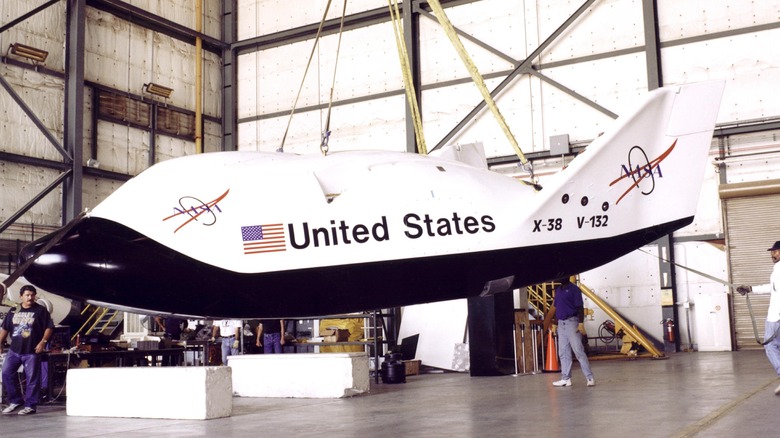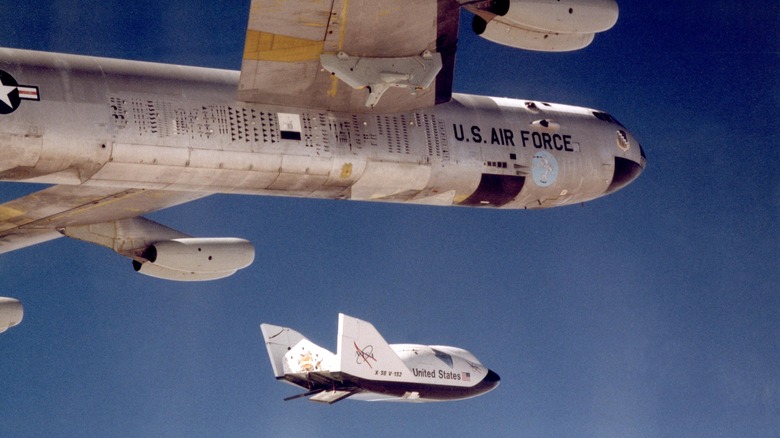NASA X-38: The Little Spacecraft With A Big Challenge
The X-38 Crew Return Vehicle (CRV) was tasked with a significant challenge: saving crew members aboard the International Space Station (ISS). Between 1963 and 1975, NASA's Flight Research Center and the U.S. Air Force collaborated on a project that tested out a myriad of designs for wingless vehicles that could be piloted from space down back through Earth's atmosphere and land like a conventional airplane at a preset location.
This "lifting body" fleet was tested at Edwards Air Force Base and included several prototypes ( M2-F1, M2-F2, M2-F3, HL-10, X-24A, and the X-24B). But the X-24A's design is the one NASA borrowed the most from when it came time to create the X-38.
The rescue vehicle had to bring the entire crew of the ISS safely back to Earth within a five-hour window and on total autopilot if any crew members were injured or incapacitated. It also needed to be flight ready at a moment's notice, fit inside the bay of the Space Shuttle to get up to the ISS, resist the damage of the harshness of space for three years, and be able to launch and separate in minutes in case a catastrophic event occurred.
A global collaboratively built space lifeboat
The X-38 was a collaborative effort. It involved the Johnson Space Center, Langley Research Center, Dryden Flight Research Center, and a contingent from the European Space Agency (ESA).
A team from the Netherlands built the rudders, while one from Spain fashioned the landing skids. The Germans came up with a composite material for the thermal protection system on the nose, France provided aerodynamics and thermodynamics work on the overall vehicle shape, while Belgium built structural parts for the aft of the vehicle.
The team had to overcome two enormous challenges. First, it had to build a custom human space rescue vehicle, which had never been done before. Second, it had to be done at a reduced cost. A whole fleet had to cost less than half of one entire Space Shuttle. And, despite an initial estimate of over $2 billion, the X-38 came in significantly under budget — about one-quarter of that original estimate.
What the team built was, in effect, three crafts in one. The "spacecraft" portion of the X-38 had a deorbit propulsion module to escape the station, then maneuver through space and re-enter Earth's atmosphere. The "lifting body" of the vehicle had to automatically lock in and fly towards a landing site as it dropped to Earth in case its human payload was incapacitated or incapable of flying.
On a wing and a prayer
It also needed something from old school parachute equipped capsules — set down lightly, at very low speeds, on a set of reliable skids. Only this vehicle was equipped with a much, much larger and steerable parafoil, not a parachute.
The parafoil used by the X-38 was the largest in the world with over 6 million stitches. When fully open, it covered 7,500 square feet and could carry 25,000 pounds.
The X-38 was the first spacecraft to use a composite skin, which helped reduce weight. Instead of high-maintenance hydraulics, a combination of electromechanical actuators and electric motors moved the flaps and rudders.
Five prototypes were built. The final version would have been 30 feet long. However, before the X-38 could be completed, NASA decided to scrap the entire project in 2002 due to budget cuts. The V132 prototype is now on display at the Strategic Air and Space Museum in Ashland, Nebraska.

